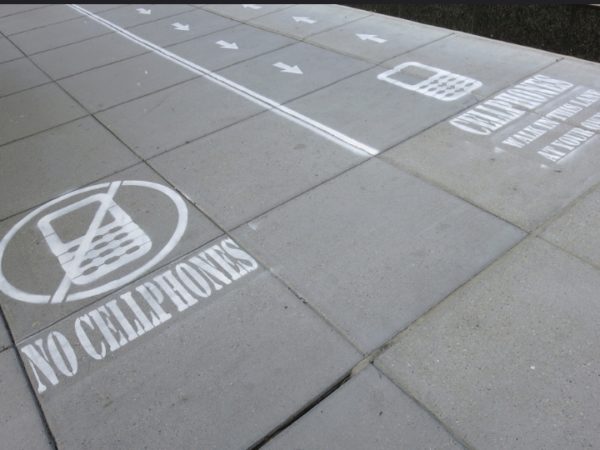
 Washington’s new, unofficial cell phone lane covers a block on 18th Street. (Photo by Rob Pegoraro)[/caption]
Washington’s new, unofficial cell phone lane covers a block on 18th Street. (Photo by Rob Pegoraro)[/caption]
A television program called “Mind Over Masses” has been conducting a social experiment that many may find it easy to get behind. Indeed, some of us have been waiting for this program for decades, perhaps without even really knowing it.
The National Geographic Channel program is testing dividing a sidewalk in Washington. D.C. into two lanes; one is labelled “No Cellphones”. The other “Cellphones Walk in This Lane at Your Own Risk”.
The Associated Press’s Jessica Gresko reported that “A notice on the website of the city’s Office of Motion Picture and Television Development said the new science series “uses what we know about human behavior” to develop “interactive solutions to everyday problems.” The notice said the show planned to create “Fast and slow lanes” on the sidewalk, “allowing participants to choose.”
So is the experiment returning harmony and courtesy back to the streets? Sadly no, the AP reports that many pedestrians are simply ignoring the sidewalk instructions…
So is the experiment returning harmony and courtesy back to the streets? Sadly no, the AP reports that many pedestrians are simply ignoring the sidewalk instructions. More pictures are available here.
When did a lack of sidewalk etiquette become a thing? In some cities, I’m looking at you New York, you will be mowed down if you don’t follow some simple rules. Stick to the right. Look where you are going. Keep a good distance. Don’t play games on your cell phone. It’s simple stuff, right?
No mention of a cell phone lane, but things have gotten so bad that there is even a “Pedestrian Etiquette” entry on Wikipedia.
“Pedestrian etiquette is the general courtesy expected from those walking among other pedestrians. Pedestrian etiquette involves staying out of the way of fellow pedestrians and not hindering their ability to travel. Doing this prevents collisions that may potentially cause injury or damage to person or property,” the entry begins, logically.
Do not suddenly stop. Do not stand in the middle of the pathway. Do not step on people’s heels. Walk on the right side. Simple, right?
Some of the other tips that are glaringly obvious to nine out of ten of us (okay six out of ten).
“Don’t suddenly stop”.
“Don’t fill the width of the path when walking in groups”.
“Don’t step on people’s heels”.
“Do not stand in the middle of a pathway”.
“Look both ways before stepping onto a path”.
These things are so elementary that some kids at MIT have designed a pedestrian-friendly robot that can find its way around sidewalks with ease.
“Socially aware navigation is a central capability for mobile robots operating in environments that require frequent interactions with pedestrians,” says Yu Fan “Steven” Chen, former MIT graduate student and lead author of a new study demonstrating their autonomous robot, in a press release.
“For instance, small robots could operate on sidewalks for package and food delivery,” says Chen. “Similarly, personal mobility devices could transport people in large, crowded spaces, such as shopping malls, airports, and hospitals.”
Leave a Reply
You must be logged in to post a comment.



 Share
Share Tweet
Tweet Share
Share




Comment